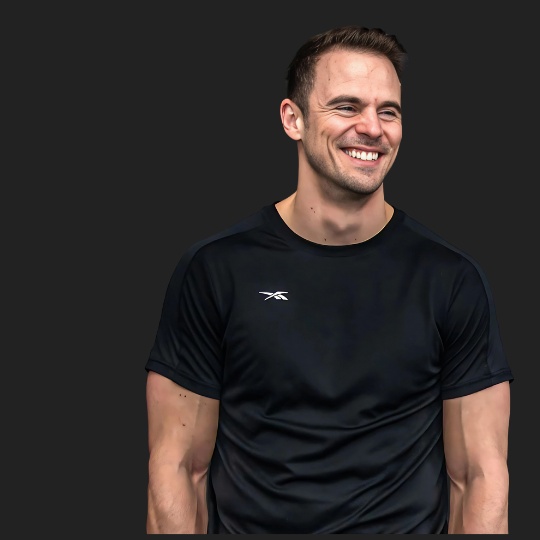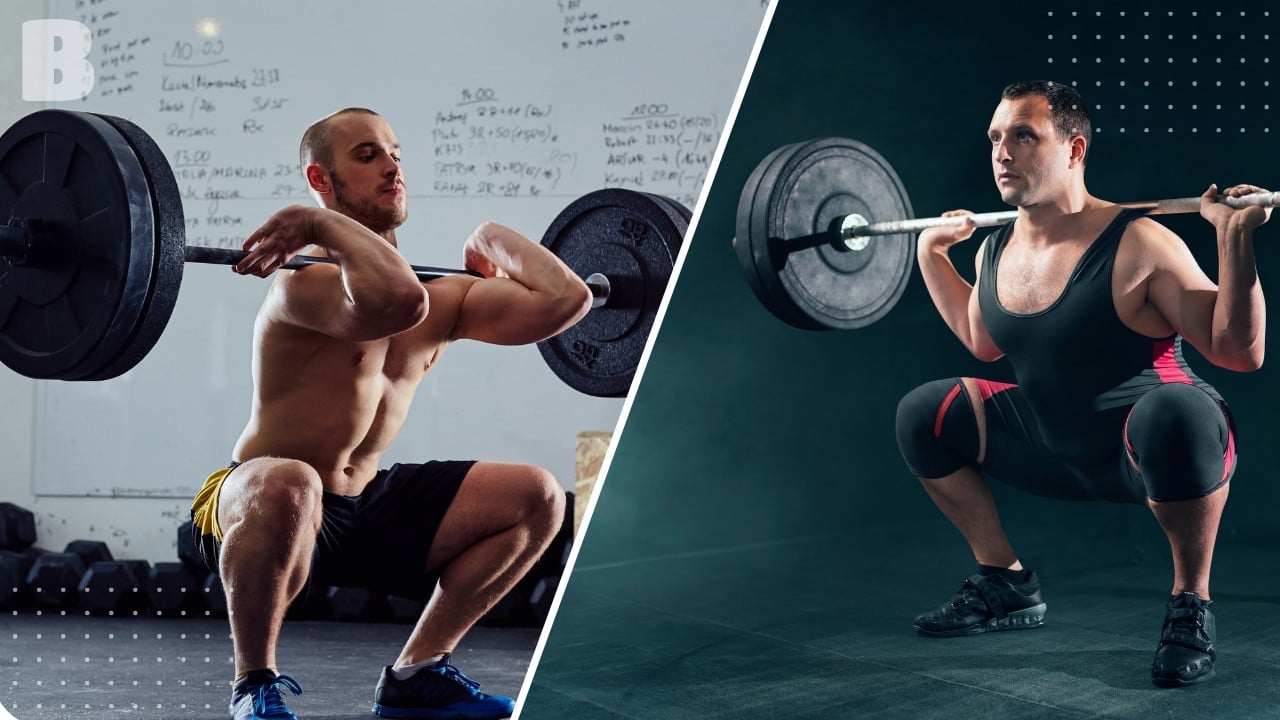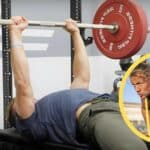Exploring the differences between front and back squats reveals insights critical for enhancing your fitness routine.
This article breaks down the technical distinctions, from bar positioning to muscle activation, and examines how each variation impacts strength, muscle growth, and injury prevention.
Whether aiming to boost athletic performance or refine your workout, understanding these squats’ benefits and challenges is essential.
How do they align with your fitness goals and health needs? We guide you through selecting the right squat for your regimen, considering personal goals and biomechanical factors, to optimize your strength training outcomes.
Jump to:
- What’s The Difference Between a Front Squat and a Back Squat?
- Muscle Recruitment and Joint Strain
- The Case for Back Squats
- The Case for Front Squats
- How To Perform The Front Squat
- How To Perform the Back Squat
- Master These Exercise Variations Before Barbell Back Squats
- Front Squat vs. Back Squat Ratio
- Practical Applications and Considerations
- Addressing Common Concerns
- Making the Right Choice for You
- Which Squat Will Be Best for You?
What’s The Difference Between a Front Squat and a Back Squat?
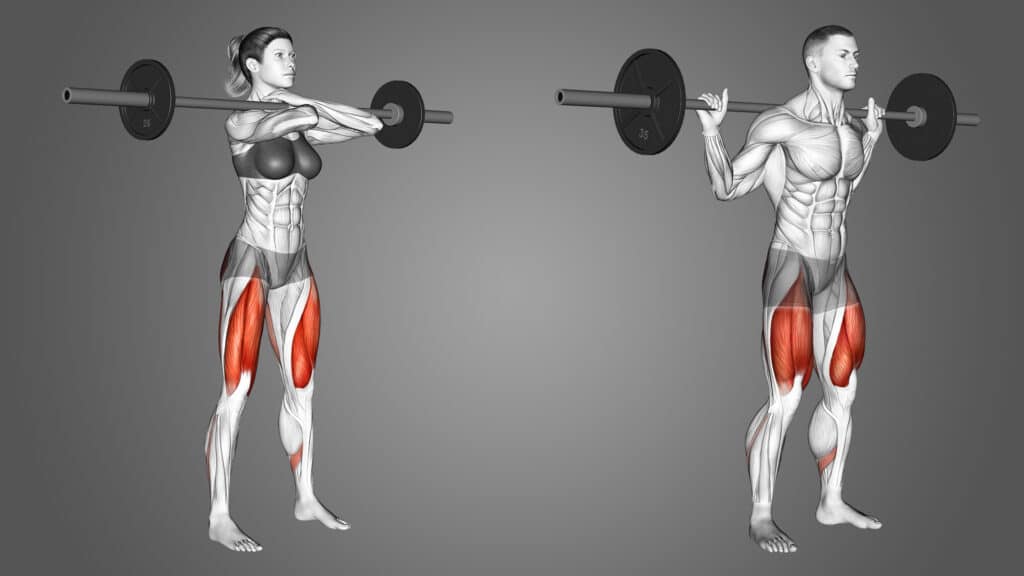
Bar Position
In front squats, athletes rest the barbell on the front shoulders, close to the clavicles, with elbows pointing forward. This positioning demands significant upper body strength to maintain the bar in place.
Conversely, back squats involve placing the barbell on the trapezius muscle or just below it on the upper back, allowing for heavier weights to be lifted due to the more stable bar position.
Body Posture
Front squats require an upright torso to prevent the bar from rolling off the shoulders, emphasizing thoracic extension and core stability. This posture reduces the strain on the lower back.
Back squats, however, allow for a slight forward lean, shifting the focus to the posterior chain muscles, including the glutes and hamstrings.
Biomechanics and Muscle Activation
Front squats engage the quads more intensely and distribute forces more evenly across the knee and hip joints, reducing stress on the lower back. They also demand more from the anterior core muscles to stabilize the weight.
Back squats generate higher compressive forces on the spine and knee joints but involve more muscle mass, including the posterior chain, leading to potentially greater overall strength and muscle gains.
Muscle Recruitment and Joint Strain
Detailed comparison of muscle activation in front and back squats
Electromyographic (EMG) studies reveal front squats elicit greater activation in the quadriceps and anterior core muscles, making them ideal for targeting these areas specifically.
Back squats, with their unique body lean, engage the glutes, hamstrings, and erector spinae to a greater extent, offering a comprehensive lower body and posterior chain workout.
Discussion on joint strain and implications for individuals with pre-existing conditions
Front squats present a lower risk of aggravating lower back pain due to the upright posture, which decreases lumbar spine loading.
They are beneficial for those with knee concerns as well, as the squat’s depth and form encourage proper knee tracking over toes. For individuals with a history of shoulder or wrist injuries, back squats might be preferable, given the less demanding position on these joints.
However, because back squats can place more strain on the spine and knees, those with pre-existing back or knee issues should proceed with caution, possibly favoring front squats or consulting a medical professional before incorporating heavy back squats into their routine.
The Case for Back Squats
Back Squats Build Athleticism
Back squats are foundational for enhancing athletic performance. By engaging a broad spectrum of muscle groups, including the glutes, hamstrings, quadriceps, and core, this exercise variant not only strengthens the lower body but also improves overall power and explosiveness.
Athletes across various sports rely on back squats to increase their vertical jump, sprint speed, and endurance on the field or court.
Back Squats Build Your Backside
Targeting primarily the posterior chain, back squats are particularly effective for developing the glutes and hamstrings.
This emphasis on the backside not only contributes to athletic performance but also aids in injury prevention by balancing muscle strengths and ensuring proper alignment and functionality of the lower body.
Variations of Back Squats
- High-Bar Back Squat: Ideal for those seeking to prioritize quadriceps development, the high-bar back squat requires an upright torso, which translates to more depth and increased quad activation.
- Safety Bar Squat: Designed to reduce strain on the shoulders, wrists, and elbows, the safety bar squat allows for a comfortable position while still targeting the lower body effectively. It’s a valuable alternative for those with upper body injuries or mobility issues.
The Case for Front Squats
The Front Squat Doesn’t Let You Lift With Ego
Front squats demand precision and form over sheer weight, compelling athletes to focus on technique rather than the amount of weight lifted.
This focus on quality over quantity ensures the development of strength and muscular endurance in a way that promotes long-term health and performance.
The Front Squat Gives You Greater Core Activation
Due to the anterior placement of the barbell, front squats require significant core engagement to maintain balance and posture.
This constant activation strengthens the abdominal and lower back muscles, contributing to a solid core foundation that supports everyday movements and athletic endeavors.
Variations of Front Squats
- Goblet Squat: Accessible to beginners and valuable for all fitness levels, the goblet squat allows for a deep range of motion while enhancing stability and control. It’s a practical way to master squatting mechanics and core engagement with minimal equipment.
- Zercher Squat: Carrying the bar in the crook of the elbows, the Zercher squat challenges balance, core stability, and lower body strength. It’s a unique variation that also increases upper body and grip strength, offering a comprehensive workout.
How To Perform The Front Squat
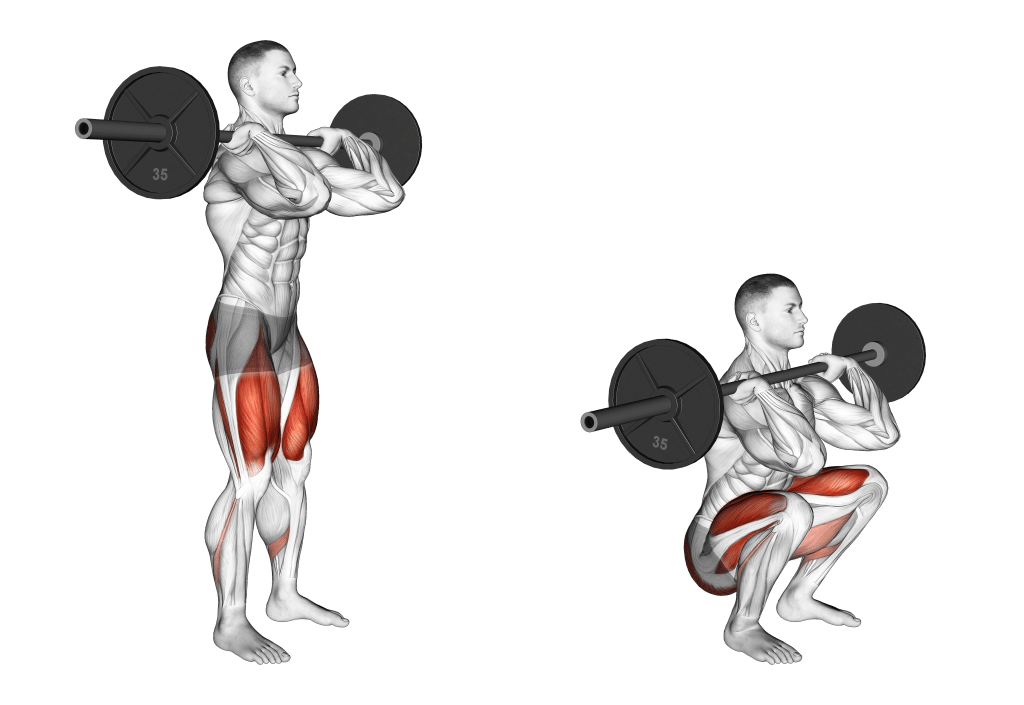
Step-by-step guide
- Position Your Feet: Stand with feet shoulder-width apart, toes slightly pointed out.
- Grip and Bar Placement: Extend arms under the bar, keeping elbows high to create a shelf with your shoulders for the bar to rest. Ensure the bar is close to the neck without putting pressure on it.
- Unrack the Bar: With the bar resting on your shoulders, carefully lift off from the rack by straightening your legs and stepping back.
- Descend: Begin the squat by pushing hips back and bending knees. Keep the chest up and elbows high, descending until thighs are at least parallel to the ground.
- Ascend: Drive through heels to return to the starting position, maintaining a high elbow position and upright chest throughout the movement.
Using Straps To Front Squat
For those struggling with wrist flexibility, using straps attached to the bar can help. Wrap straps around the bar and hold onto them with a tight grip, keeping elbows up.
This method allows for a comfortable front squat without the demand on wrist flexibility.
How To Perform the Back Squat
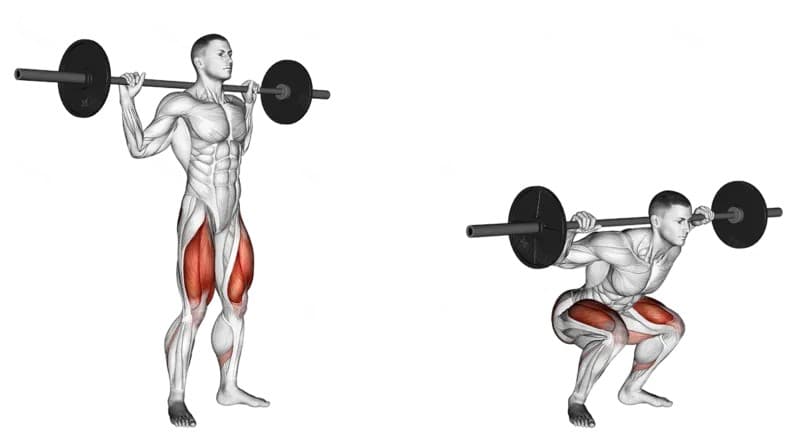
Step-by-step guide
- Bar Positioning: Step under the bar, placing it across the upper back. Depending on preference, this can be on the traps (high bar) or just above the rear deltoids (low bar).
- Foot Placement: Position feet slightly wider than shoulder-width, toes pointing outward.
- Unracking the Bar: With a tight grip on the bar, straighten legs to lift the bar off the rack. Step back into starting position.
- Executing the Squat: Keeping the core tight, bend knees and hips to lower into the squat. Aim to get your hips below knee level while keeping the weight on your heels.
- Returning to Start: Drive through your heels, extending hips and knees to return to the standing position.
Master These Exercise Variations Before Barbell Back Squats
Incorporating specific exercises can enhance strength and technique necessary for effective back squatting:
- Bodyweight Squats: Perfect for beginners, focusing on form and depth without added weight.
- Goblet Squats: Holding a kettlebell or dumbbell close to the chest teaches proper squat depth and torso alignment.
- Box Squats: Squatting to a box ensures consistent depth while building the power to stand up from the bottom position of a squat.
- Leg Press: While not a direct squat variation, the leg press machine can help build leg strength that translates to better squatting capabilities.
Front Squat vs. Back Squat Ratio
Explaining the optimal ratio for balanced development
Achieving a balanced development of strength and muscle involves incorporating both front and back squats into a training regimen.
The optimal ratio may vary based on individual goals and biomechanics, but a general guideline suggests a 3:4 ratio of front squat weight to back squat weight.
This ratio ensures that athletes and fitness enthusiasts develop strength in both the anterior and posterior chains, maintaining muscle balance and reducing injury risk.
Practical Applications and Considerations
Sport-Specific Training Considerations
Different athletic disciplines require distinct physical capabilities. Front squats, with their emphasis on the quadriceps and core stability, are particularly beneficial for athletes involved in sports that demand upright posture, explosive leg strength, and balance, such as weightlifting and gymnastics.
The increased core activation supports movements requiring body control and stability.
Back squats, by targeting the posterior chain, are indispensable for sports requiring powerful hip extension, sprinting speed, and jumping ability, such as football, basketball, and track and field.
This squat variant enhances the ability to generate force from the lower body, crucial for explosive movements.
For Strength and Muscle
Both squat variations are foundational for building strength and muscle mass, but they contribute differently.
Front squats focus the workload more on the anterior portion of the lower body, leading to significant strength gains in the quadriceps and an improvement in core strength and stability. They are ideal for developing a balanced physique and enhancing functional strength.
Back squats, given their ability to handle heavier loads, are superior for overall muscle building and strength, particularly in the glutes, hamstrings, and lower back.
Incorporating back squats into a routine maximizes muscle hypertrophy and overall lower body power, essential for lifting heavy weights and improving athletic performance.
Addressing Common Concerns
How to Avoid Lower Back Pain From Squats
Proper form is crucial to avoid lower back pain from squats. Maintaining a neutral spine, avoiding excessive forward lean, and not letting the knees cave inward are key. Engaging the core throughout the movement can also protect the lower back.
For those predisposed to lower back issues, front squats may be a safer option due to the upright torso position, which places less strain on the lumbar spine.
Considerations for Knee Health and Achilles Tendon Load
Knee health is paramount in both squat variations. Ensuring proper alignment by tracking knees over toes and avoiding excessive forward knee travel can prevent undue stress on the knee joints.
Front squats may be beneficial for individuals concerned with knee health, as the upright position allows for a more balanced distribution of forces.
Regarding the Achilles tendon, back squats can put more load on this area, especially with deep squatting. Proper warm-up, stretching, and gradually increasing squat depth can help mitigate the risk of Achilles tendon strain.
For those with a history of Achilles issues, front squats or variations that place less emphasis on dorsiflexion may be advisable.
Making the Right Choice for You
Is a Front Squat Harder Than a Back Squat?
Difficulty is subjective and varies based on individual strengths, weaknesses, and flexibility. Front squats may seem harder for those with less core strength and upper body flexibility, as they require a strong torso to keep the barbell in place and maintain an upright position.
Conversely, back squats might be challenging for individuals lacking posterior chain strength. Assessing personal areas of strength can guide you in identifying which might initially feel more challenging.
Do Front Squats and Back Squats Work the Same Muscles?
While both squat variations engage major lower body muscles, the emphasis differs. Front squats target the quadriceps and core more intensely, whereas back squats place more focus on the glutes, hamstrings, and lower back.
Incorporating both into your routine ensures a comprehensive lower body workout.
Can Front Squats Replace Back Squats?
Front squats can complement back squats but may not fully replace them, especially if your goal is to maximize posterior chain development and overall strength.
Each variation offers unique benefits; thus, integrating both might provide a more balanced muscle development and strength gain.
Should You Add Front Squats to Your Routine?
Yes, especially if you’re seeking balanced muscle development, improved core strength, and enhanced athletic performance.
Front squats encourage proper posture and help in strengthening the anterior chain, which is beneficial for overall functional fitness and injury prevention.
Which Squat Will Be Best for You?
Selecting the right squat type depends on personal goals, health considerations, and training preferences. If your objective is to build explosive power and strengthen the posterior chain, back squats may be more beneficial.
Conversely, if you aim to enhance core stability, quad strength, and maintain an upright posture, front squats could be preferable.
Consider your current health status, particularly any knee or lower back issues, when choosing your squat type.
Front squats may be more appropriate for those with lower back problems, while individuals with knee concerns should approach squatting with caution, focusing on proper form and potentially favoring variations that place less stress on the knees.
Ultimately, combining both squat variations, when possible, can lead to a well-rounded fitness routine, addressing both anterior and posterior development, improving overall strength, and minimizing injury risks.

